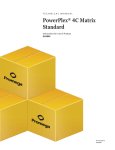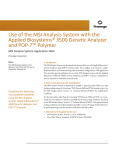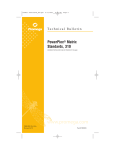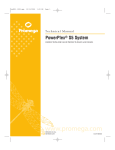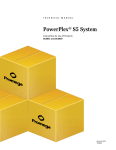Download Complete Protocol
Transcript
TECHNICAL BULLETIN PowerPlex® Matrix Standards, 3100/3130 InstrucƟons for use of Product DG4650 Note: The PowerPlex® Matrix Standards, 3100/3130, can be used to perform spectral calibraƟon on the Applied Biosystems 3500 and 3500xL GeneƟc Analyzers. Revised 6/13 TBD022 PowerPlex® Matrix Standards, 3100/3130 All technical literature is available on the Internet at: www.promega.com/protocols/ Please visit the web site to verify that you are using the most current version of this Technical Bulletin. Please contact Promega Technical Services if you have questions on use of this system. E-mail: [email protected] 1. Description..........................................................................................................2 2. Product Components and Storage Conditions ............................................3 3. Instrument Preparation and Spectral Calibration Using the Applied Biosystems® 3500 and 3500xL Genetic Analyzers ................4 A. Matrix Sample Preparation.................................................................................4 B. Instrument Preparation .......................................................................................6 4. Instrument Preparation and Spectral Calibration Using Data Collection Software, Version 2.0 or Version 3.0 (ABI PRISM® 3100 and 3100-Avant and Applied Biosystems® 3130 and 3130xl Genetic Analyzers).............................................................10 A. Matrix Sample Preparation...............................................................................10 B. Instrument Preparation .....................................................................................12 5. PowerPlex® Spectral Calibration File Generation Using Data Collection Software, Version 1.0.1 or Version 1.1 (ABI PRISM® 3100 and 3100-Avant Genetic Analyzers) .........................13 A. B. C. D. E. F. Spectral Run Module .........................................................................................14 Spectral Parameters............................................................................................14 Matrix Sample Preparation...............................................................................15 Instrument Preparation .....................................................................................16 Spectral Calibration Run ...................................................................................17 Spectral Calibration Results..............................................................................17 6. Troubleshooting...............................................................................................18 A. Applied Biosystems® 3500 and 3500xL Genetic Analyzers .........................18 B. ABI PRISM® 3100 and 3100-Avant and Applied Biosystems® 3130 and 3130xl Genetic Analyzers .................................................................19 7. Related Products ..............................................................................................20 Promega Corporation · 2800 Woods Hollow Road · Madison, WI 53711-5399 USA Toll Free in USA 800-356-9526 · Phone 608-274-4330 · Fax 608-277-2516 · www.promega.com Printed in USA. Revised 6/13 Part# TBD022 Page 1 1. Description 5789TA Proper generation of a spectral calibration file is critical to evaluate multicolor systems with the ABI PRISM® 3100 and 3100-Avant and Applied Biosystems® 3130, 3130xl, 3500 and 3500xL Genetic Analyzers. The PowerPlex® Matrix Standards, 3100/3130, includes individual fragments labeled with four different fluorescent dyes (Figure 1). Each matrix fragment is provided in a separate tube: one tube contains a fragment labeled with fluorescein (FL), one tube contains a fragment labeled with 6-carboxy-4´,5´-dichloro-2´,7´-dimethoxyfluorescein (JOE), one tube contains a fragment labeled with carboxy-tetramethylrhodamine (TMR), and one tube contains a fragment labeled with carboxy-X-rhodamine (CXR). Figure 1. PowerPlex® Matrix Standards, 3100/3130, on the Applied Biosystems® 3130 Genetic Analyzer using Data Collection Software, version 3.0. This figure shows the CXR (red), TMR (yellow), JOE (green) and FL (blue) peaks in the spectral viewer from one of the four capillaries. Promega Corporation · 2800 Woods Hollow Road · Madison, WI 53711-5399 USA Toll Free in USA 800-356-9526 · Phone 608-274-4330 · Fax 608-277-2516 · www.promega.com Part# TBD022 Page 2 Printed in USA. Revised 6/13 These matrix fragments are mixed and used on the ABI PRISM® 3100 or 3100-Avant or Applied Biosystems® 3130, 3130xl, 3500 or 3500xL Genetic Analyzer to perform a spectral calibration for a specified dye set. For Data Collection Software, versions 1.0.1 and 1.1, the spectral calibration should be performed on dye set Z using dye set F parameters. For Data Collection Software, version 2.0 and 3.0, the spectral calibration should be performed on dye set F. The instructions for use with the Applied Biosystems® 3500 and 3500xL Genetic Analyzers were generated with 3500 Data Collection Software, v1.0 HID, on an Applied Biosystems® 3500xL Genetic Analyzer. A spectral calibration file is generated for a specific set of dyes, array type (4, 8 16 or 24 capillaries) and array length (36cm). Once generated, this file is applied during sample detection to calculate the spectral overlap between the four different dye colors and separate the raw fluorescent signals into individual dye signals. The PowerPlex® Matrix Standards, 3100/3130, was developed for use with the PowerPlex® 16, 16 HS, S5 and CS7 Systems and the PowerPlex® 16 and ES Monoplex Systems and can be used with any of the GenePrint® Fluorescent STR Systems. A matrix should be generated for each individual instrument. Protocols to operate the fluorescence-detection instruments should be obtained from the manufacturer. Technical Manuals and additional product information are available at: www.promega.com 2. Product Components and Storage Conditions Product PowerPlex® Matrix Standards, 3100/3130 Not for Medical Diagnostic Use. Includes: • • • • • 25µl 25µl 25µl 25µl 1.25ml Cat.# DG4650 Fluorescein Matrix JOE Matrix TMR Matrix CXR Matrix Nuclease-Free Water Storage Conditions: Store all components at –30 to –10°C in a nonfrost-free freezer. Do not store reagents in the freezer door, where the temperature can fluctuate. The fragments in the matrix standards are light-sensitive and must be stored in the dark. We strongly recommend that the matrix standards be stored with post-amplification reagents and used separately with different pipettes, tube racks, etc. Promega Corporation · 2800 Woods Hollow Road · Madison, WI 53711-5399 USA Toll Free in USA 800-356-9526 · Phone 608-274-4330 · Fax 608-277-2516 · www.promega.com Printed in USA. Revised 6/13 Part# TBD022 Page 3 3. Instrument Preparation and Spectral Calibration Using the Applied Biosystems 3500 and 3500xL Genetic Analyzers Materials to Be Supplied by the User • 95°C dry heating block, water bath or thermal cycler • crushed ice or ice-water bath • centrifuge compatible with 96-well plates • aerosol-resistant pipette tips • 3500/3500xL capillary array, 36cm • performance optimized polymer 4 (POP-4® polymer) in a pouch for the 3500 or 3500xL • anode buffer container with 1X running buffer • cathode buffer container with 1X running buffer • MicroAmp® optical 96-well plate and septa • Hi-Di™ formamide (Applied Biosystems Cat.# 4311320) ! ! The quality of formamide is critical. Use Hi-Di™ formamide. Freeze formamide in aliquots at –20°C. Multiple freeze-thaw cycles or long-term storage at 4°C may cause breakdown of formamide. Poor-quality formamide may contain ions that compete with DNA during injection, which results in lower peak heights and reduced sensitivity. A longer injection time may not increase the signal. Formamide is an irritant and a teratogen; avoid inhalation and contact with skin. Read the warning label, and take the necessary precautions when handling this substance. Always wear gloves and safety glasses when working with formamide. For additional information on performing spectral calibration, refer to the Applied Biosystems® 3500/3500xL Genetic Analyzer User Guide. 3.A. Matrix Sample Preparation ! There may be instrument-to-instrument variation in the sensitivity of detection. The dilutions described here may need to be optimized in individual laboratories depending on the sensitivity of each Applied Biosystems® 3500 or 3500xL Genetic Analyzer. The optimal dilution may differ for each dye. 1. Thaw the matrix standards. Mix each matrix standard by vortexing for 5–10 seconds prior to use. Do not centrifuge the matrix standards as this may cause the DNA to be concentrated at the bottom of the tube. 2. Initial dilution of concentrated fragments: Before combining the matrix standards, dilute the individual matrix standards 1:10 in Nuclease-Free Water, as described below. Vortex for 5–10 seconds to mix. Matrix Standard Nuclease-Free Water FL 5µl 45µl JOE 5µl 45µl TMR 5µl 45µl CXR 5µl 45µl Promega Corporation · 2800 Woods Hollow Road · Madison, WI 53711-5399 USA Toll Free in USA 800-356-9526 · Phone 608-274-4330 · Fax 608-277-2516 · www.promega.com Part# TBD022 Page 4 Printed in USA. Revised 6/13 3. Fragment mix (using 1:10 dilutions of matrix standards): After the initial dilution in Step 2, combine the 1:10 dilution of each matrix standard as directed below. Vortex for 5–10 seconds to mix. Component Hi-Di™ formamide FL from initial dilution JOE from initial dilution TMR from initial dilution CXR from initial dilution Volume 668µl 8.0µl 8.0µl 8.0µl 8.0µl Note: Differences in instrument sensitivity may result in peak imbalance or reduced peak height. You may need to prepare a new plate and adjust the dilution of individual matrix dyes. Peak heights in the range of 1,000–4,000RFU are ideal. Peak heights above 750RFU and below the saturation point of the instrument are required. Use the worksheet below to record the dilutions used with your capillary electrophoresis instrumentation. Component Hi-Di™ formamide FL from initial dilution JOE from initial dilution TMR from initial dilution CXR from initial dilution Volume 4. On the Applied Biosystems® 3500xL Genetic Analyzer, only wells A1 to H3 of the 96-well plate are used for spectral calibration. Load 25μl of the fragment mix prepared in Step 3 into each of the 24 wells. After placing the septa on the plate, briefly centrifuge the plate to remove bubbles. On the Applied Biosystems® 3500 Genetic Analyzer, only wells A1 to H1 of the 96-well plate are used for spectral calibration. Load 25μl of the fragment mix prepared in Step 3 into each of the 8 wells. After placing the septa on the plate, briefly centrifuge the plate to remove bubbles. 5. Denature samples at 95°C for 3 minutes, then immediately chill on crushed ice or in an ice-water bath for 3 minutes. Denature samples just prior to loading the instrument. 6. Place the plate in the 3500 series 96-well standard plate base, and cover with the plate retainer. Place the plate assembly in Position A on the autosampler with the labels facing you. Promega Corporation · 2800 Woods Hollow Road · Madison, WI 53711-5399 USA Toll Free in USA 800-356-9526 · Phone 608-274-4330 · Fax 608-277-2516 · www.promega.com Printed in USA. Revised 6/13 Part# TBD022 Page 5 3.B. Instrument Preparation 9247TA 1. Set the oven temperature to 60°C, then select “Start Pre-Heat” at least 30 minutes prior to the first injection to preheat the oven (Figure 2). Figure 2. The Dashboard. Promega Corporation · 2800 Woods Hollow Road · Madison, WI 53711-5399 USA Toll Free in USA 800-356-9526 · Phone 608-274-4330 · Fax 608-277-2516 · www.promega.com Part# TBD022 Page 6 Printed in USA. Revised 6/13 2. To perform a spectral calibration with the Promega 4-dye chemistry, a new dye set should be created. If a new dye set already has been created, proceed to Section 3.B, Step 2.c. a. To create this new dye set, navigate to the Library, highlight “Dye Sets” and select “Create”. 9322TA b. The Create a New Dye Set tab will appear (Figure 3). Name the Dye Set, select “Matrix Standard” for the Chemistry and select “F Template” for the Dye Set Template. Select “Save”. Figure 3. Create New Dye Set. Promega Corporation · 2800 Woods Hollow Road · Madison, WI 53711-5399 USA Toll Free in USA 800-356-9526 · Phone 608-274-4330 · Fax 608-277-2516 · www.promega.com Printed in USA. Revised 6/13 Part# TBD022 Page 7 3.B. Instrument Preparation (continued) c. To perform the spectral calibration with the Promega 4-dye chemistry, go to the Maintenance tab, select “Spectral”, and under the Calibration Run tab, choose the appropriate fields: Choose “Matrix Standard” from the Chemistry Standard pull-down menu and the new Promega 4-dye set created in Step 2b from the Dye Set pull-down menu (Figure 4). A d. Select “Start Run”. Figure 4. Calibration Run. Promega Corporation · 2800 Woods Hollow Road · Madison, WI 53711-5399 USA Toll Free in USA 800-356-9526 · Phone 608-274-4330 · Fax 608-277-2516 · www.promega.com Part# TBD022 Page 8 Printed in USA. Revised 6/13 3. If fewer than the recommended number of capillaries pass, the spectral calibration run will be repeated automatically up to three times. Upon completion of the spectral calibration, check the quality of the spectral in the Capillary Run Data display (Figure 5), and choose either “Accept” or “Reject” (not shown). 9324TA Note: Refer to the 3500 Series Data Collection Software Version 1.0 HID User Manual for the criteria recommended by Applied Biosystems when accepting or rejecting a spectral calibration. Figure 5. The Capillary Run Data display. Note: Some Applied Biosystems® 3500 and 3500xL Genetic Analyzers show imbalance in peak heights (e.g., peaks in the red and yellow dye channels are higher than those in the blue and green dye channels). You may choose to optimize the dilution of each dye separately to obtain balanced matrix standard peaks. Promega Corporation · 2800 Woods Hollow Road · Madison, WI 53711-5399 USA Toll Free in USA 800-356-9526 · Phone 608-274-4330 · Fax 608-277-2516 · www.promega.com Printed in USA. Revised 6/13 Part# TBD022 Page 9 4. Instrument Preparation and Spectral Calibration Using Data Collection Software, Version 2.0 or Version 3.0 (ABI PRISM® 3100 and 3100-Avant and Applied Biosystems® 3130 and 3130xl Genetic Analyzers) Materials to Be Supplied by the User • 95°C dry heating block, water bath or thermal cycler • crushed ice or ice-water bath • centrifuge compatible with 96-well plates • 3100 or 3130 capillary array, 36cm • performance optimized polymer 4 (POP-4® polymer) for the 3100 or 3130 • 10X genetic analyzer buffer with EDTA • MicroAmp® optical 96-well plate • aerosol-resistant pipette tips • Hi-Di™ formamide (Applied Biosystems Cat.# 4311320) ! ! The quality of formamide is critical. Use Hi-Di™ formamide. Freeze formamide in aliquots at –20°C. Multiple freeze-thaw cycles or long-term storage at 4°C may cause breakdown of formamide. Poor-quality formamide may contain ions that compete with DNA during injection, which results in lower peak heights and reduced sensitivity. A longer injection time may not increase the signal. Formamide is an irritant and a teratogen; avoid inhalation and contact with skin. Read the warning label, and take the necessary precautions when handling this substance. Always wear gloves and safety glasses when working with formamide. 4.A. Matrix Sample Preparation There may be instrument-to-instrument variation in the sensitivity of detection. The dilutions described here may need to be optimized in individual laboratories depending on the sensitivity of each ABI PRISM® 3100 or 3100-Avant or Applied Biosystems® 3130 or 3130xl Genetic Analyzer. The optimal dilution may differ for each dye fragment. You also may need to adjust injection time or voltage in Section 4.B to achieve a passing spectral calibration. Peak heights in the range of 1,000–4,000RFU are ideal. Peak heights above 750RFU and below the saturation point of the instrument are required. The same plate of matrix standards can be re-injected up to four times. To re-inject the same matrix standards plate, add an injection by selecting “Plate Manager”, then “Edit”. Select “Edit” again in the top left corner of the window, then select “Add single run”. 1. Thaw the matrix standards. Mix each matrix standard by vortexing for 5–10 seconds prior to use. Do not centrifuge the matrix standards as this may cause the DNA to be concentrated at the bottom of the tube. Promega Corporation · 2800 Woods Hollow Road · Madison, WI 53711-5399 USA Toll Free in USA 800-356-9526 · Phone 608-274-4330 · Fax 608-277-2516 · www.promega.com Part# TBD022 Page 10 Printed in USA. Revised 6/13 2. Initial dilution of concentrated fragments: Before combining the matrix standards, dilute the individual matrix standards 1:10 in Nuclease-Free Water. Vortex for 5–10 seconds to mix. Concentrated Dye Nuclease-Free Water FL 5µl 45µl JOE 5µl 45µl TMR 5µl 45µl CXR 5µl 45µl 3. Fragment mix (using 1:10 dilutions of matrix standards): After the initial dilution in Step 2, combine the 1:10 dilutions as directed below. Vortex for 5–10 seconds to mix. Component Hi-Di™ formamide FL from initial dilution JOE from initial dilution TMR from initial dilution CXR from initial dilution Volume 480µl 5.0µl 5.0µl 5.0µl 5.0µl Note: Differences in instrument sensitivity may result in peak imbalance or reduced peak height. You may need to prepare a new plate and adjust the dilution of individual matrix dyes. Peak heights in the range of 1,000–4,000RFU are ideal. Peak heights above 750RFU and below the saturation point of the instrument are required. Use the worksheet below to record the dilutions used with your capillary electrophoresis instrumentation. Component Hi-Di™ formamide FL from initial dilution JOE from initial dilution TMR from initial dilution CXR from initial dilution Volume 4. On the ABI PRISM® 3100 and Applied Biosystems® 3130xl Genetic Analyzers, 16 wells are used for spectral calibration on 16 capillaries (wells A1 through H2 of a 96-well plate). Load 25µl of the fragment mix prepared in Step 3 into each of the 16 wells. Briefly centrifuge the plate to remove bubbles. On the ABI PRISM® 3100-Avant and Applied Biosystems® 3130 Genetic Analyzers, four wells are used for matrix detection on the four capillaries (wells A1 through D1 of a 96-well plate). Load 25µl of fragment mix in each of the four wells. Briefly centrifuge the plate to remove bubbles. 5. Denature samples at 95°C for 3 minutes, then immediately chill on crushed ice or in an ice-water bath for 3 minutes. Denature samples just prior to loading the instrument. Promega Corporation · 2800 Woods Hollow Road · Madison, WI 53711-5399 USA Toll Free in USA 800-356-9526 · Phone 608-274-4330 · Fax 608-277-2516 · www.promega.com Printed in USA. Revised 6/13 Part# TBD022 Page 11 4.B. Instrument Preparation 1. Prepare the matrix samples as previously described in Section 4.A. Note: Differences in instrument sensitivity may result in peak imbalance or reduced peak height. You may need to adjust injection time or voltage to achieve a passing spectral calibration. Peak heights in the range of 1,000–4,000RFU are ideal. Peak heights above 750RFU and below the saturation point of the instrument are required. 2. Perform the spectral calibration as described in the ABI PRISM® 3100 or 3100-Avant or Applied Biosystems® 3130 or 3130xl Genetic Analyzer user’s manuals with the following modifications: a. In the Module Manager, select “New.” Select “Spectral” in the Type drop-down list, and select “Spect36_POP4” in the Template drop-down list. Confirm or change the following settings: Inj. kV: Inj. Secs: Data Delay Time: Run Time: 3 5 100 800 seconds b. Select “Save As”, and save the module with a new name. c. In the Protocol Manager, under Instrument Protocols, select “New.” Type a name for your protocol. Make the following selections in the Protocol Editor: • • • • “Spectral” in the Type drop-down list “F” in the DyeSet drop-down list “36” in the Array Length drop-down list Select the spectral module you created in the previous step in the Run Module drop-down list. Finally, select “Edit Parameters.” Change the lower condition bound to 4.0, and change the upper condition bound to 12.0. Select “OK” in the Edit Parameters window, and select “OK” in the Protocol Manager. Note: The condition number (“C value”) obtained when generating a spectral calibration will vary with the instrument. After obtaining a spectral calibration that performs acceptably, the condition bounds range in the previous step may be narrowed to more critically evaluate C values for subsequent spectral calibrations. d. In the New Plate Dialog screen, create a new plate record as described in the instrument user’s manual. In the dialog box that appears, select “Spectral Calibration” in the Application drop-down list, and select “96-well” as the plate type. Add entries in the owner and operator windows, name the plate and select “OK.” Promega Corporation · 2800 Woods Hollow Road · Madison, WI 53711-5399 USA Toll Free in USA 800-356-9526 · Phone 608-274-4330 · Fax 608-277-2516 · www.promega.com Part# TBD022 Page 12 Printed in USA. Revised 6/13 e. In the Spectral Calibration Plate Editor Dialog box, record sample names in the appropriate cells. In the Instrument Protocol column, select the protocol you created in Step 2.b. Ensure that this information is present for each row that contains a sample name. Select “OK.” f. Run your plate as described in the instrument user’s manual. g. Upon completion of the run, check the status of the spectral run in the Event Log window. For the ABI PRISM® 3100 and Applied Biosystems® 3130xl Genetic Analyzers, we recommend that a minimum of 12 of 16 capillaries pass calibration. For the ABI PRISM® 3100-Avant and Applied Biosystems® 3130 Genetic Analyzers, we recommend that a minimum of three of four capillaries pass calibration. If fewer than the recommended numbers of capillaries pass, repeat the injection (see Section 4.B, Step 2). If the spectral calibration still does not pass, repeat the spectral calibration. 5. PowerPlex® Spectral Calibration File Generation Using Data Collection Software, Version 1.0.1 or Version 1.1 (ABI PRISM® 3100 and 3100-Avant Genetic Analyzers) Note: To create a successful spectral calibration, two file modifications must be made; the first involves the run module, and the second involves the parameter file. These instructions only apply to Data Collection Software, versions 1.0.1 and 1.1. For instructions to generate a spectral calibration using Data Collection Software, version 2.0 or 3.0, see Section 4. Materials to Be Supplied by the User • Hi-Di™ formamide (Applied Biosystems Cat.# 4311320) • 95°C dry heating block, water bath or thermal cycler • crushed ice or ice-water bath • centrifuge compatible with 96-well plates • 3100 capillary array, 36cm • performance optimized polymer 4 (POP-4® polymer) for the 3100 instruments • 10X genetic analyzer buffer with EDTA • MicroAmp® optical 96-well plate • aerosol-resistant pipette tips ! The quality of formamide is critical. Use Hi-Di™ formamide. Freeze formamide in aliquots at –20°C. Multiple freeze-thaw cycles or long-term storage at 4°C may cause breakdown of formamide. Poor-quality formamide may contain ions that compete with DNA during injection, which results in lower peak heights and reduced sensitivity. A longer injection time may not increase the signal. ! Formamide is an irritant and a teratogen; avoid inhalation and contact with skin. Read the warning label, and take the necessary precautions when handling this substance. Always wear gloves and safety glasses when working with formamide. Promega Corporation · 2800 Woods Hollow Road · Madison, WI 53711-5399 USA Toll Free in USA 800-356-9526 · Phone 608-274-4330 · Fax 608-277-2516 · www.promega.com Printed in USA. Revised 6/13 Part# TBD022 Page 13 5.A. Spectral Run Module 1. Open the ABI PRISM® 3100 Data Collection Software. 2. In the Tools menu, open the Module Editor. Select the Calibration tab, then select the “Spect36_POP4DefaultModule” module. 3. Confirm or change the settings for the following: Inj. kV: 3 Inj. Secs: 5 Data Delay Time: 100 Run Time: 800 seconds 4. Select “Save As”, and save the module with a new name (for example, Spect36_POP4PowerPlex). Use this as the initial run module for all spectral calibration runs using the PowerPlex® Matrix Standards, 3100/3130. Note: There may be instrument-to-instrument variation in the sensitivity of detection. You may have to modify the injection time or voltage depending on the sensitivity of each instrument. 5.B. Spectral Parameters 1. To customize the spectral parameters, locate the parameter file at: My Computer/3100files (D:)\AppliedBio\Support Files\Data Collection Support Files\Calibration Data\Spectral Calibration\ParamFiles 2. Select “MtxStd{Genescan_SetF}”. This will open the .par file in Microsoft Notepad. 3. Change the condition bounds range to [4.0, 12.0] 4. Select “File Save As” to save the parameter file with a new name (for example, MtxStd{Genescan_ SetZPowerPlex}.par). Use this as the parameter file for all spectral calibration runs using the PowerPlex® Matrix Standards, 3100/3130. Note: The condition number (“C value”) obtained when generating a spectral calibration will vary with the instrument. After obtaining a spectral calibration that performs acceptably, the condition bounds range in the previous step may be narrowed to more critically evaluate C values for subsequent spectral calibrations. 5.C. Matrix Sample Preparation There may be instrument-to-instrument variation in the sensitivity of detection. The dilutions described here may need to be optimized in individual laboratories depending on the sensitivity of each ABI PRISM® 3100 or 3100-Avant or Applied Biosystems® 3130 or 3130xl Genetic Analyzer. The optimal dilution may differ for each dye fragment. You also may need to adjust injection time or voltage in Section 4.B to achieve a passing spectral calibration. Peak heights in the range of 1,000–4,000RFU are ideal. Peak heights above 750RFU and below the saturation point of the instrument are required. Promega Corporation · 2800 Woods Hollow Road · Madison, WI 53711-5399 USA Toll Free in USA 800-356-9526 · Phone 608-274-4330 · Fax 608-277-2516 · www.promega.com Part# TBD022 Page 14 Printed in USA. Revised 6/13 The same plate of matrix standards can be re-injected up to four times. To re-inject the same matrix standards plate, add an injection by selecting “Plate Manager”, then “Edit”. Select “Edit” again in the top left corner of the window, then select “Add single run”. 1. Thaw the matrix standards. Mix each matrix standard by vortexing for 5–10 seconds prior to use. Do not centrifuge the matrix standards as this may cause the DNA to be concentrated at the bottom of the tube. 2. Initial dilution of concentrated fragments: Before combining the matrix standards, dilute the individual matrix standards 1:10 in Nuclease-Free Water. Vortex for 5–10 seconds to mix. Concentrated Dye Nuclease-Free Water FL 5µl 45µl JOE 5µl 45µl TMR 5µl 45µl CXR 5µl 45µl 3. Fragment mix (using 1:10 dilutions of matrix standards): After the initial dilution in Step 2, combine the 1:10 dilutions as directed below. Vortex for 5–10 seconds to mix. Component Hi-Di™ formamide FL from initial dilution JOE from initial dilution TMR from initial dilution CXR from initial dilution Volume 480µl 5.0µl 5.0µl 5.0µl 5.0µl Note: Differences in instrument sensitivity may result in peak imbalance or reduced peak height. You may need to prepare a new plate and adjust the dilution of individual matrix dyes. Peak heights in the range of 1,000–4,000RFU are ideal. Peak heights above 750RFU and below the saturation point of the instrument are required. Use the worksheet below to record the dilutions used with your capillary electrophoresis instrumentation. Component Hi-Di™ formamide FL from initial dilution JOE from initial dilution TMR from initial dilution CXR from initial dilution Volume 4. On the ABI PRISM® 3100 Genetic Analyzer, 16 wells are used for spectral calibration on 16 capillaries (wells A1 through H2 of a 96-well plate). Load 25µl of the fragment mix prepared in Step 3 into each of the 16 wells. Briefly centrifuge the plate to remove bubbles. Promega Corporation · 2800 Woods Hollow Road · Madison, WI 53711-5399 USA Toll Free in USA 800-356-9526 · Phone 608-274-4330 · Fax 608-277-2516 · www.promega.com Printed in USA. Revised 6/13 Part# TBD022 Page 15 5.C. Matrix Sample Preparation (continued) On the ABI PRISM® 3100-Avant Genetic Analyzer, four wells are used for spectral calibration on four capillaries (wells A1 through D1 of a 96-well plate). Load 25µl of the fragment mix in each of the four wells. Briefly centrifuge the plate to remove bubbles. 5. Denature samples at 95°C for 3 minutes, then chill immediately on crushed ice or in an ice-water bath for 3 minutes. Denature samples just prior to loading the instrument. 5.D. Instrument Preparation These instructions apply only when using the Data Collection Software, version 1.0.1 or 1.1. Refer to the instrument user’s manual for instructions on cleaning the pump blocks, installing the capillary array, performing a spectral calibration and adding polymer to the reserve syringe. Differences in instrument sensitivity may result in peak imbalance or reduced peak height. The dilutions described here may need to be optimized in individual laboratories depending on the sensitivity of each ABI PRISM® 3100 or 3100-Avant Genetic Analyzer. The optimal dilution may differ for each dye fragment. You also may need to adjust injection time or voltage in Section 5.C to achieve a passing spectral calibration. Peak heights in the range of 1,000–4,000RFU are ideal. Peak heights above 750RFU and below the saturation point of the instrument are required. 1. Open the ABI PRISM® 3100 Data Collection Software. 2. Open a new plate record. Name the plate, and select “Spectral Calibration”. Select “96-well” as the plate type. Select “Finish”. 3. Complete the plate record spreadsheet for the wells you have loaded. Enter appropriate information into the Sample Name column. 4. In the Dye Set column, select “Z” from the pull-down menu. 5. In the Spectral Run Module column, select “Spect36_POP4PowerPlex” from the pull-down menu. This is the module that was created in Section 5.A. 6. In the Spectral Parameters column, select “mtxStd{Genescan_SetZ PowerPlex}” from the pull-down menu. This is the file that was created in Section 5.B. The resulting spectral plate record should have the following settings: Dye Set: Spectral Run Module: Spectral Parameters: Z Spect36_POP4PowerPlex MtxStd{Genescan_SetZPowerPlex} 7. Select “OK”. This new plate record will appear in the pending plate records table on the plate setup page of the data collection software. Promega Corporation · 2800 Woods Hollow Road · Madison, WI 53711-5399 USA Toll Free in USA 800-356-9526 · Phone 608-274-4330 · Fax 608-277-2516 · www.promega.com Part# TBD022 Page 16 Printed in USA. Revised 6/13 5.E. Spectral Calibration Run 1. In the pending plate records table, click once on the name of the plate record you just created. 2. Once the plate record is highlighted, select the plate graphic that corresponds to the plate on the autosampler that contains your spectral calibration samples. 3. When the plate record is linked to the plate, the plate graphic will change from yellow to green, the plate record moves from the pending plate records table to the linked plate records table, and the Run Instrument button becomes enabled. 4. Select the Run Instrument button on the toolbar to start the spectral calibration run. 5.F. Spectral Calibration Results 1. After the spectral calibration run is completed, the Spectral Calibration Result window opens, indicating which capillaries passed calibration. A “.” indicates the capillary passed. An “X” indicates the capillary failed. 2. Select “OK”. 3. Review the spectral calibration data. In the Tools menu of the data collection software, select “Display Spectral Calibration”. 4. Select the Dye Set button, select “Dye Set Z” from the pull-down menu and select “OK”. 5. The Matrices for Dye Set Z window displays the spectral calibration data for each capillary. Use the scroll bar to review the data for each of the 16 capillaries. For the PowerPlex® Matrix Standards, 3100/3130, the following conditions must be met for the capillary to pass calibration: a. The Q-value must be greater than 0.95. b. The condition number (or C-value) must fall within the range previously determined in Section 5.B, Step 3. c. The peak height values must be above 750RFU and below the saturation point of the instrument. 6. Select “OK” to close the window. 7. If a capillary fails calibration, it will automatically be assigned the spectral data from the nearest passing capillary to the left. To achieve an effective spectral calibration file, we recommend that a minimum of 12 out of 16 capillaries pass calibration for the ABI PRISM® 3100 Genetic Analyzer. For the ABI PRISM® 3100-Avant Genetic Analyzer, we recommend that a minimum of three of the four capillaries pass calibration. If fewer than the recommended number of capillaries pass, repeat the injection. To re-inject the same matrix standards plate, add an injection by selecting “Plate Manager”, then “Edit”. Select “Edit” again in the top left corner of the window, then select “Add single run”. The same plate of matrix standards can be re-injected up to four times. If the spectral calibration still does not pass, repeat the spectral calibration. Promega Corporation · 2800 Woods Hollow Road · Madison, WI 53711-5399 USA Toll Free in USA 800-356-9526 · Phone 608-274-4330 · Fax 608-277-2516 · www.promega.com Printed in USA. Revised 6/13 Part# TBD022 Page 17 6. Troubleshooting For questions not addressed here, please contact your local Promega Branch Office or Distributor. Contact information available at: www.promega.com. E-mail: [email protected] 6.A. Applied Biosystems® 3500 and 3500xL Genetic Analyzers Symptoms Causes and Comments Fewer than the recommended number of capillaries passed the spectral calibration Matrix standards were too dilute. Matrix samples that are too dilute will result in low peak heights. Decrease the dilution of each fragment in Step 2 of Section 3.A. Matrix standards were too concentrated. Matrix samples that are too concentrated may result in bleedthrough or oversubtraction in other dye colors, which may result in spectral calibration failure. Increase the dilution of each fragment in Step 2 of Section 3.A. Samples were not denatured completely. Incomplete denaturation can cause extra peaks in one of all color channels. Heat-denature samples for the recommended time, and cool on crushed ice or in an ice-water bath immediately prior to loading the capillary. Do not cool samples in a thermal cycler or –20°C freezer. All capillaries failed spectral calibration Monitoring fragment migration in the Capillaries Viewer during the spectral calibration run can provide information that might be useful for troubleshooting purposes. Note any unusual peak formations or extremely high or low peak heights. Promega Corporation · 2800 Woods Hollow Road · Madison, WI 53711-5399 USA Toll Free in USA 800-356-9526 · Phone 608-274-4330 · Fax 608-277-2516 · www.promega.com Part# TBD022 Page 18 Printed in USA. Revised 6/13 6.B. ABI PRISM® 3100 and 3100-Avant and Applied Biosystems® 3130 and 3130xl Genetic Analyzers Symptoms Causes and Comments Fewer than the recommended number of capillaries passed the spectral calibration Differences in instrument sensitivity may result in peak imbalance or reduced peak heights. You may need to adjust injection time or voltage to achieve a passing spectral calibration. The same plate of matrix standards can be re-injected up to four times. Alternatively, you may need to prepare a new plate and adjust the dilution of individual matrix dyes. Peak heights in the range of 1,000–4,000RFU are ideal. Peak heights above 750RFU and below the saturation point of the instrument are required. Matrix standards were too dilute. Matrix samples that are too dilute will result in low peak heights. If matrix peak heights are below 1,000RFU, decrease the dilution of each fragment in Step 2 of Section 4.A or 5.C. Matrix standards were too concentrated. Matrix sample peak heights that are too high may result in bleedthrough or oversubtraction in other dye colors, which may result in spectral calibration failure. If matrix sample peak heights are too high (>6,000RFU), increase the dilution of each fragment in Step 2 of Section 4.A or 5.C and repeat the spectral calibration run. Another option is to decrease the injection time so that less sample is injected. Incomplete denaturation can cause extra peaks in one or all color channels. Heat-denature samples for the recommended time, and cool on crushed ice or in an ice-water bath immediately prior to loading the capillary. Do not cool samples in a thermal cycler or –20°C freezer. For best spectral calibration results, use a fresh bottle of polymer, fresh buffer and water, and a capillary array with fewer than 100 injections. All capillaries failed spectral calibration Monitoring fragment migration in the Capillaries Viewer during the spectral calibration run can provide information that might be useful for troubleshooting purposes. Reinject the spectral calibration plate, and monitor the Capillaries Viewer during the run. Note any unusual peak formations or extremely high or low peak heights. Promega Corporation · 2800 Woods Hollow Road · Madison, WI 53711-5399 USA Toll Free in USA 800-356-9526 · Phone 608-274-4330 · Fax 608-277-2516 · www.promega.com Printed in USA. Revised 6/13 Part# TBD022 Page 19 7. Related Products Product PowerPlex® 16 HS System PowerPlex® 16 System PowerPlex® CS7 System PowerPlex® S5 System Size 100 reactions 400 reactions 100 reactions 400 reactions 100 reactions 100 reactions 400 reactions Cat.# DC2101 DC2100 DC6531 DC6530 DC6613 DC6951 DC6950 Size 50ml Cat.# P1193 Not for Medical Diagnostic Use. Accessory Components Product Nuclease-Free Water For Laboratory Use. © 2006, , 2009, 2010, 2013 Promega Corporation. All Rights Reserved. GenePrint and PowerPlex are registered trademarks of Promega Corporation. ABI PRISM, Applied Biosystems and MicroAmp are registered trademarks of Applied Biosystems. Hi-Di is a trademarks of Applera Corporation. POP-4 is a registered trademark of Life Technologies Corporation. Products may be covered by pending or issued patents or may have certain limitations. Please visit our Web site for more information. All prices and specifications are subject to change without prior notice. Product claims are subject to change. Please contact Promega Technical Services or access the Promega online catalog for the most up-to-date information on Promega products. Promega Corporation · 2800 Woods Hollow Road · Madison, WI 53711-5399 USA Toll Free in USA 800-356-9526 · Phone 608-274-4330 · Fax 608-277-2516 · www.promega.com Part# TBD022 Page 20 Printed in USA. Revised 6/13






















